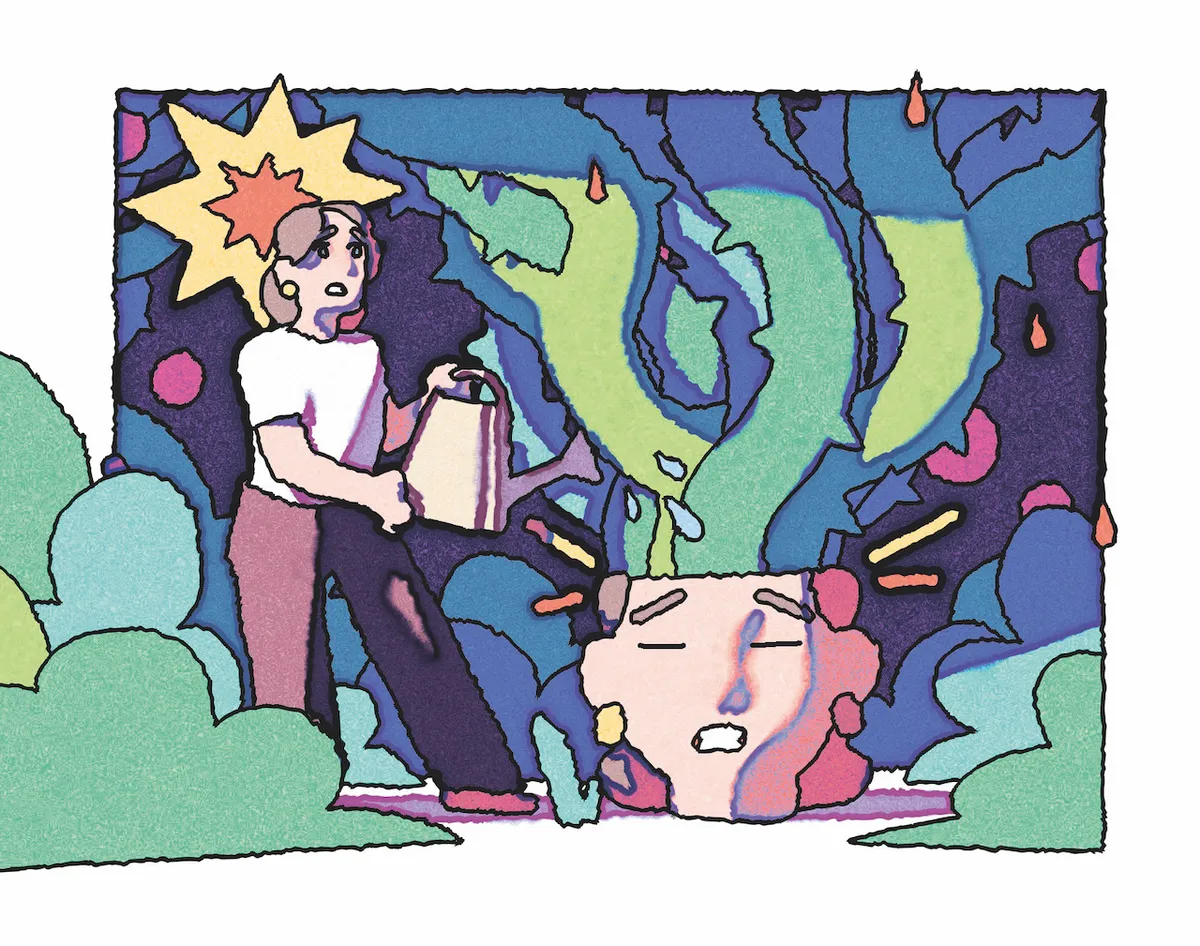In the context of mental health, a phobia is far more serious than a mild aversion. Many of us dislike flying, or giving a talk in front of our colleagues, and we might not be too happy if a large, slobbery dog, no matter how gentle, came bounding toward us. But as long as we can tolerate these kinds of situations without too much distress, and our lives aren’t adversely affected, then we haven’t got a phobia for any of these situations as such.
In contrast, people diagnosed with a relevant phobia would experience an intense, extremely unpleasant fear reaction that could be overwhelming. So much so, that it might interfere with their day-to-day lives.
Flying phobias, social phobias, and a fear of dogs (even cute ones) are common examples –but there are dozens of others, including some quite bizarre examples, such as trypophobia, which is a fear of clusters of holes (like you get in crumpets), sedatephobia (a fear of silence) and gerascophobia (a fear of ageing).
What are phobias?
Phobias are a formal psychiatric diagnosis in the anxiety category. To be diagnosed, you’d need to have experienced a phobia for at least six months, and your fear reactions to the focus of your phobia would need to be out of proportion to the danger you were in.
Psychiatry recognises five main categories of ‘specific phobia’ (between3 to 15 per centof people will develop one of these at some point in their lives): animal phobias (spiders and snakes are common examples); environmental phobias (such as heights or deep water); blood/injection phobias (think needles or the mere sight of blood); situational phobias (such as bridges or dentists); and finally an ‘other’ category that covers almost everything else, such as a fear of swallowing or being sick.
Aside from the specific phobias, there’s ‘social phobia’ (also known as ‘social anxiety’ which affectsup to 12 per centof people at some point) and agoraphobia (affecting around1 per centof people).
A lot of people misconceive agoraphobia as being a fear of going outside, or of open spaces, but actually it’s more accurately described as a fear of being in any kind of situation where escape might be impossible, so it could manifest as a fear of being stuck in traffic, for instance.
How phobias affect the brain
There is a network of brain structures, known as the limbic system, that is involved in fear and anxiety and the acquisition of phobias. Perhaps the most important structure is the amygdala (there’s one on each side of the brain), which plays a significant role in learning fears.
Imagine as a kid, hearing a buzzing sound and then getting stung by a wasp –your amygdala would play a key role in helping you learn an association between the buzzing sound and the future risk of getting stung.
If the fear is intense enough, the amygdala will communicate with other parts of the limbic system such as the hypothalamus, to help initiate the fight or flight response, and the hindbrain (including the brainstem), to trigger a startle response such as quickly withdrawing your stung hand. It’s the activation of the fight or flight response that can make a phobic reaction so overpowering –think rapid heart rate, fast breathing, nausea, panic and sweating.
Phobias list – the rarest and weirdest phobias
Genuphobia
The fear of knees (genu is Latin for knees), which can manifest in different ways, such as an irrational fear of the sight of them, or even intense worries about sustaining a knee injury or kneeling.
Bambakomallophobia
The fear of cotton wool (the formal term is made up of the Greek words for cotton and wool). “I feel sick at the thought of the very particular way in which it would feel and squeak between my fingers,” sufferer Chris Hall told The Guardian in 2019.
Pogonophobia
The fear of beards (pogon is Greek for beard) and is reportedly more common in women than men. In some cases, a little stubble is all it takes to set off the phobia. The late British prime minister Margaret Thatcher was reportedly a sufferer.
Haphephobia
The fear of being touched, even by family or friends. It’s not a skin sensitivity problem, rather it’s an aversion to the idea of being touched. The fictional character Christian Grey, from Fifty Shades Of Grey, is described as suffering from this phobia.
Trypophobia
Trypophobia, the fear of holes, is from the Greek word for holes trýpa. For people with this phobia, cheese, crumpets, or anything featuring a cluster of holes can be enough to trigger a fear reaction.
How do you develop a phobia?
Some phobias develop out of natural aversions. For instance, a dislike of spiders, or of heights, can intensify over time until the point that it becomes a phobia. At first, the experience might be fairly mild. Imagine seeing a spider, finding it scary and wanting to get away from it. But over time, if that aversion became a preoccupation and it started to cause problems in life, then it would have become a diagnosable phobia.
For instance, imagine finding it difficult to go to sleep at night out of fear that there could be a spider lurking under the bed, or in the shadows. Or finding the sight of a spider in the corner of the office or classroom so distressing that you had to leave the room.
Similarly with heights –finding a high, precarious position uncomfortable is common and understandable, but feeling so scared of heights that you can’t work on a high floor in a tower block, or can’t go on a school geography trip to the cliffs, would suggest a phobia.

Other phobias can emerge more dramatically – they might follow a particularly scary, unpleasant incident, such as a painful wasp sting as a child leading to a phobia.
Avoidance of the source of fear will typically fuel a phobia. For instance, if you always avoided spiders, or heights, or wasps, you’d never get to experience the fact that they’re not usually a threat, and so your fear of them could fester, and then grow over time.
Is it possible to ‘inherit’ a phobia?
You can’t literally inherit a specific phobia through your genes, but some people seem to be more predisposed to develop phobias than others –and this tends to run in families. To return to the childhood wasp sting, for many people this would soon be forgotten, but for those with a more anxious, fearful temperament –perhaps at least partly inherited via their genes – it would be more likely to develop into a full-blown phobia.
Part of this vulnerability might be related to the way that some people, but not others, actually begin to fear their fearful reaction to certain triggers (essentially, they develop a fear of fear, finding it really scary and unpleasant).
To an extent, it’s also possible to acquire phobias from others. If you are raised in a family that’s intensely frightened of flying, for example, then it’s more likely that you too would develop your own fear of flying (and of course this ‘modelling’, as it’s known, will also interact with genetic vulnerabilities).
Bear in mind, too, that it seems to be especially easy and common to develop phobias for things that would have threatened the survival of our ancestors –such as heights and snakes. As a rule, fear in moderation is useful and helps keep you alive, but it’s when it gets out of hand that it becomes a phobia.
Can phobias be treated?
Phobias can sometimes abate by themselves, and they are also highly treatable. Popular approaches to treatment have evolved over time. Psychoanalytic methods that see phobias as an outward expression of hidden emotional problems have largely fallen out of fashion.
These days, you are more likely to be taught relaxation techniques to help you gain control over your fear reaction, and this will be combined with gradual exposure to the focus of your phobia, so that you can learn that it’s not as dangerous as you think.
Cutting-edge interventions use virtual reality or augmented reality to help you overcome a phobia –these methods allow fine control over the intensity of the source of your fear (for example, by altering the size of a spider, or the height of a ladder) and act as a useful stepping stone on the way to confronting the fear for real. At the experimental stage are investigations using beta-blockers and other compounds to interfere with the brain-basis of acquired fears.
Weird phobias
In theory, it’s possible to develop an intense fear of pretty much anything, and in different eras the focuses of people’s fears have changed.
For example, in the early days of train travel, there was a lot of interest in various forms of train phobia (‘siderodromophobia’), such as fear of missing them –psychologist Sigmund Freud was reportedly a sufferer – or of the physical sensations they cause.

In more recent times, there’s been much talk of ‘nomophobia’, which is a fear of being without your mobile phone, either because it’s run out of juice or because you’ve lost it. Relatedly, people talk today of a ‘fear of missing out’ (FOMO) which can be triggered by a lack of access to social media, or other forms of information.
Sometimes long-known phobias can manifest in new ways. For instance, there’s ‘scopophobia’ – the fear of being stared at – which has acquired a new relevance in the age of Zoom meetings.
Another contemporary phobia that’s probably on the milder end of the spectrum, is agmenophobia or the fear that you’ve chosen to join the wrong queue –usually the slow one.
Read more:

